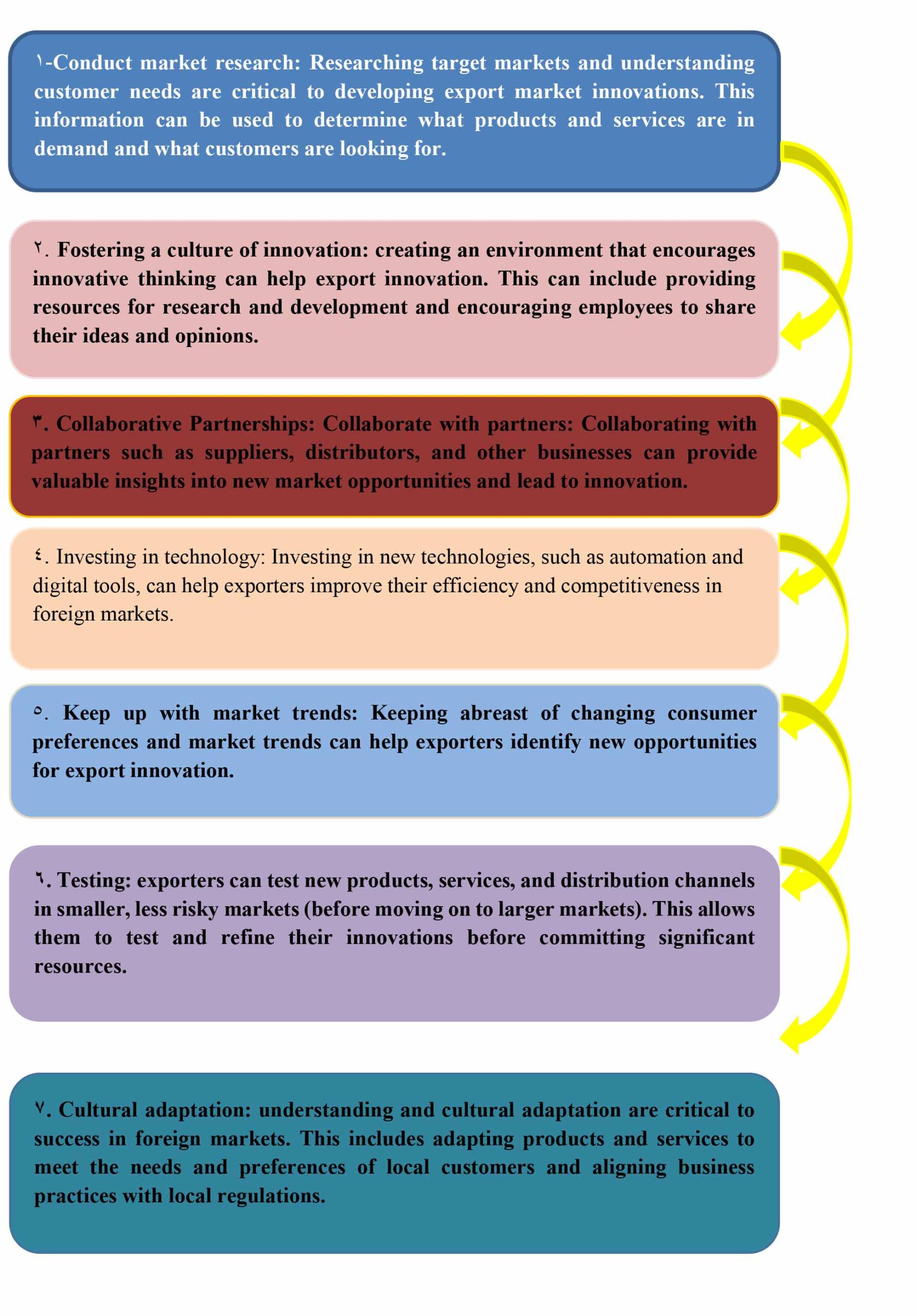
Exporting plays an important role in business strategy, and many scholars believe that its importance will continue to grow as globalization increases. The knowledge acquired by a company through its experience in the export market is the key to its innovative behavior and international competitiveness. Export market innovation is the main way a company acquires new knowledge during internationalization, and export product innovation is the means a company uses to successfully enter export markets. Culture encompasses “basic human norms, ideas, values, and beliefs that continually evolve over time and help determine what is considered acceptable human behavior in a society. Cultural distance is therefore defined as the extent to which shared norms and values differ from one country to another. Cultural distance in export markets is an important issue, and its management requires innovation and initiative. But how to manage cultural distance with innovation? Read this article to understand the importance of innovation in export markets.
.
Innovation in international trade
Innovation plays an important role in economic growth, international trade, and regional development. Innovation can affect international trade through the following channels:
- Improvement of products and services: Innovation leads to the development of new and improved products and services that can be traded on a global scale. This can increase a country’s competitiveness in the global market.
- Increased efficiency: innovations in technology and production processes can make international trade more efficient and cost-effective. For example, the widespread use of the Internet and digital technologies has made it easier to communicate, manage supply chains, and conduct cross-border transactions.
- Improved market access: innovations can help companies enter new markets and reach new customers. For example, new technologies can help companies overcome barriers to entry, such as language and cultural differences that have previously prevented them from doing business in a particular country.
- Diversifying exports: Innovation can help countries diversify their exports and reduce their dependence on a single product or market. This can increase the resilience of a country’s economy to fluctuations in global demand and prevent economic shocks.
.

.
In general, innovation is an important driver of international trade and economic growth. By promoting innovation, countries can increase their competitiveness, expand their market reach, and improve the efficiency and sustainability of their trade relationships. During the innovation process, ideas are translated into new products or services, new process technologies, new organizational structures or new management approaches.
What does export innovation mean?
To become more competitive internationally, a company must be able to carry out innovative activities that lead to better performance in export markets. Research and development (R&D) and product innovation are part of a company’s export activities, but export innovation, the creation of new export products and new export markets.
Export innovation refers to the process of introducing new products, services or production processes to international markets. This type of innovation involves identifying new market opportunities and developing strategies to reach those markets and provide innovative services. This innovation may involve developing new products, modifying existing products to better meet the needs of foreign customers, or using new distribution channels to reach customers. The goal of export innovation is to create new revenue streams and growth for a company by expanding its reach into new markets. It can also lead to increased competition in domestic and international markets and help raise brand awareness and reputation on a global scale.
The market innovation greatly favors the innovation of export products: what improves firm performance (and the introduction of new products is an illustration of such performance) is knowing about the market needs and its consumers’ preferences. Research shows that firms that export to developing countries are more likely to have R&D units and invest in product design, while firms that export to developing countries are more likely to Investing in new products and production processes. Exporting to developed markets requires upgrading production processes (technology) to meet marketing specifications, while exporting to developed markets requires leadership in product design and research.
.
7effective steps to create innovation in export
There are several steps companies can take to innovate their exports:
.

.
By following these steps, exporters can innovate their exports and find new opportunities for growth and success in foreign markets.
.
Export product innovation
Product innovation is the creation and introduction of a good or service that is new to the market or an improved version of a previous product. Process innovation, on the other hand, means the introduction of a new or improved method of production or delivery. Product innovation can take many forms, such as developing new products, improving existing products, or adding new features to existing products. Product innovation is an important aspect of a company’s growth strategy because it enables the company to remain competitive, differentiate itself from its competitors and offer its customers new and improved solutions.
The product innovation process typically involves several stages, including:
Ideation: This is the process where you generate ideas and solutions for new products.
Concept Development: In this stage the ideas which is generated in the ideation stage are refined and further developed into a concept that can be tested and validated.
Development and Testing: In this stage, prototypes of the product are created and tested to confirm its validity and identify problematic issues that need to be addressed.
Launch and commercialization: In this stage, the product enters the market and is commercialized. This stage includes activities such as marketing, sales and distribution.
The product innovation process usually involves several phases, including:
Ideation: This is the process in which you develop ideas and solutions for new products.
Concept development: In this phase, the ideas generated in the ideation phase are refined and developed into a concept that can be tested and validated.
Development and testing: In this phase, prototypes of the product are created and tested to confirm the validity of the concept and identify problematic issues that need to be addressed.
Market launch and commercialization: In this phase, the product is launched and commercialized. This phase includes activities such as marketing, sales and distribution.
Product innovation is a critical aspect of business success and can drive growth and competitiveness in various industries. Firms must continuously strive to innovate their products to stay ahead of competitors and meet changing customer demand. Creative exporters benefit more by changing the product, product packaging, labeling, etc. and reallocating resources from low production products to higher productivity products. In addition, innovation helps exporters improve absorptive capacity.
.

.
Market innovation in export
Market innovation refers to the process of creating new or improved products, services, or processes that meet the changing needs and expectations of customers and involves identifying new opportunities and developing new solutions to meet unmet customer needs. The goal of market innovation is to create value for customers and drive business growth by differentiating from competitors and providing new solutions to customer problems.
Market innovation is essential for companies to stay relevant and competitive in a fast-paced business environment. Through continuous innovation, companies can attract new customers, retain existing customers, and increase market share.
Market innovation in exports is important for companies that want to grow. Entering new markets gives companies access to new customers and reduces their dependence on a particular market.
To succeed in the innovation market, companies need to consider various factors such as cultural differences, regulations, and market competition.
They should also have a thorough understanding of the local market, including consumer behavior, market trends, and the competitive landscape. By innovating in the export market, companies can increase their competitiveness, expand their reach, and ultimately succeed in the global market.
.
Marketing innovation in export
A marketing innovation is the introduction of new marketing strategies or techniques that enable a company to be more active in the marketplace and reach customers in new and more effective ways. Marketing innovations can play an important role in the success of companies in global markets. Here are some examples of marketing innovations that companies can use to increase their exports:
Digital marketing: digital marketing has become increasingly important for companies looking to reach customers in foreign markets. Companies can use social media, search engine optimization (SEO) and email marketing to reach potential customers and establish their brand.
See “digital marketing in export” article
Personalization: Personalized customer experiences can help companies build closer relationships with their customers and stay competitive in the marketplace. For example, companies can use data and information to tailor their marketing messages and product offerings to their customers’ needs.
.
See “Personalization in Export” article
Brand storytelling: by telling a compelling story, brands can build an emotional connection with their audience, differentiate themselves from their competitors, and ultimately drive sales and loyalty. Companies can use storytelling in their marketing content such as videos, blogs, and social media posts to build an emotional connection with their customers and create a memorable brand experience.
Influencer marketing: working with influencers can help companies reach new audiences and build their brand in foreign markets. Exporters can work with influencers to promote their products and services through product reviews and posts on social media.
Sustainable Marketing (Green Marketing): Today, many consumers are interested in environmentally friendly and sustainable products. Companies that focus on sustainability in their marketing can differentiate themselves from their competitors and appeal to environmentally conscious consumers in foreign markets.
These are just examples of marketing innovations that companies can use to increase their exports. The key is to find the marketing strategies and techniques that work best for your company and target market, and to constantly innovate to stay ahead of the competition.
